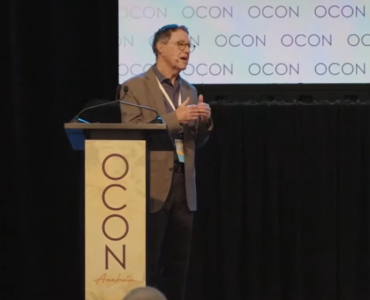Occasionally we write about what we’re currently reading, watching or listening to — not at the level of a full review, but simply to point out arguments, perspectives and issues worth considering. This is one of those articles.
Expressions of fear over climate change are reaching apocalyptic proportions:
“The world is going to end in 12 years if we don’t address climate change,” claims Alexandria Ocasio-Cortez.1 “Our house is on fire,” says 16-year-old climate activist Greta Thunberg, telling world leaders at Davos:
We are less than 12 years away from not being able to undo our mistakes. . . . I want you to panic. I want you to feel the fear I feel every day. And then I want you to act. . . . I want you to act as if the house was on fire. Because it is.2
But these apocalyptic warnings are fueled by a massive lack of perspective.
For one thing, despite the constant claim that disasters caused by man-made climate change are already happening, the end-of-the-world scenarios we’re presented with are not primarily derived from real-world data but from computer models that are demonstrably unreliable.3 According to climate scientist Judith Curry, the former chair of Georgia Tech’s School of Earth and Atmospheric Sciences, “the climate models making dire predictions of warming in the 21st century are the same models that predicted too much warming in the early 21st century, and can’t explain the warming from 1910–1945 or the mid-century grand hiatus.”4
And these scenarios ignore the bigger picture of mankind’s relationship to the climate. I’ve argued previously in favor of taking a broader look at what makes us vulnerable to climate-related risks. Doing so suggests an alternative perspective: That the changes that might occur in the climate system itself pose far less of a risk to us than do the destructive consequences of the political policies offered as “solutions” — policies such as severe restrictions on carbon-fueled industrial development and regulations that impede resilience and adaptability.5
Even if one accepts the need to plan for an increased risk of climate-related disasters, the proponents of end-of-the-world scenarios show no recognition of the life-or-death importance of abundant energy, the physical and economic realities of energy production, or the devastating consequences of the sweeping carbon-cutting policies they propose.
As a corrective to the near-panic that pervades our cultural atmosphere, what’s desperately needed is a broader perspective on the climate issue.
The book is Population Bombed!: Exploding the Link Between Overpopulation and Climate Change by Pierre Desrochers, associate professor of geography at the University of Toronto, and Joanna Szurmak, a graduate student at York University.
Published in October 2018 by the Global Warming Policy Foundation — a UK-based think tank that offers sober and scientifically rigorous perspectives on issues related to climate and energy — Population Bombed! argues that the apocalyptic warnings we’re seeing today over climate change are nothing new.
Far from being an unprecedented and uniquely intractable crisis, the climate change issue is essentially similar to previous anticipated environmental crises — crises that failed to materialize, for reasons we’ll explore below.
By offering a broad, historical perspective on these unrealized environmental fears, Population Bombed! provides a welcome corrective to the climate of panic over climate.
The fizzled population bomb
The title, Population Bombed!, is a nod to Paul Ehrlich’s 1968 bestseller The Population Bomb, a classic work in the environmentalist canon that offered forecasts as alarming in its day as today’s climate warnings are in ours.
Based on 1960s projections of world population growth in relation to global food production, Ehrlich predicted mass-starvation. “The battle to feed all of humanity is over,” he wrote. “In the 1970’s the world will undergo famines — hundreds of millions of people are going to starve to death in spite of any crash programs embarked upon now.” The only way to avert catastrophic over-population, Ehrlich insisted, was by immediate and radical population control “by compulsion if voluntary methods fail.”6
But Ehrlich’s “population bomb” failed to detonate.
Instead of worldwide famine and death, the 1970s witnessed a revolution in food production led by agricultural innovator Norman Borlaug. Despite a doubling of world population over the last fifty years, rates of poverty and hunger have steadily declined, and food production continues to grow as technological advances7 enable farmers to produce more and more food on each acre of farmland.
The essential flaw in his perspective, Desrochers and Szurmak suggest, is its failure to recognize the power of the “ever expanding human intellect” (p. 50)8 to transcend the limits of nature through technological advances.9
An analogy often used by Ehrlich and similar thinkers is the fate of bacteria in a closed petri dish, which will feed and multiply without restraint until they use up their finite food supply and die off en masse. But this model ignores the fact that, as Desrochers and Szurmak argue,
As one data point among many they reference, consider corn production in the United States. On the “bacteria” premise, one might expect our ability to grow corn to be limited by the availability of arable land and other required agricultural inputs. But in reality, even as US population has grown, corn production has increased by an order of magnitude over 150 years. Thanks to numerous innovations, farmers have been able to produce dramatically more with fewer resources.unique among other species, modern humans transmit information and knowledge between individuals and through time, innovate by combining existing things in new ways, and engage in long-distance trade, thus achieving, to a degree, a decoupling from local limits. (p. xvii)
Not only have farmers produced more corn per acre, but their yield has completely decoupled from acreage and other inputs such that, according to environmental scientist Jesse Ausubel, “American farmers have quintupled corn [production] while using the same or even less land.” “Crucially,” he writes,
rising yields have not required more tons of fertilizer or other inputs. The inputs to agriculture have plateaued and then fallen — not just cropland but nitrogen, phosphates, potash, and even water.10
Multiply this kind of “decoupling” between production and resources across all industries and it becomes clear that mankind is not constrained by the same limitations applicable to blindly multiplying bacteria.
And it sheds light on why throughout history prophets of doom such as Ehrlich have always failed so dramatically in their predictions.
A long history of failed predictions . . . and improved human well-being
One of the chief values of Population Bombed! is its comprehensive historical research.
Paul Ehrlich was far from the first person to make spectacularly wrong predictions based on fear of unchecked population growth. For centuries, there have been thinkers who’ve expressed the idea that mankind’s impact on its environment is inherently destructive, and that an ever-increasing human population will soon find itself unable to marshal the resources needed for continued survival.
The works of such thinkers and their critics have given rise to a long-standing historical debate between “two main perspectives on the relationship between humans and nature,” which Desrochers and Szurmak designate as the “pessimists” versus the “optimists.”
One [the optimist perspective] argues that we can and should reshape the natural world for our own benefit. The other is that humanity should live within natural limits and that failing to do so will result in considerable harm. (p. 7)
Arguably, these competing perspectives go back millennia, but their modern form is generally traced to Thomas Malthus’s 1798 work An Essay on the Principle of Population. Anticipating Ehrlich by two centuries, Malthus famously argued, on mathematical grounds, that unchecked population growth must inevitably outstrip food production causing mass starvation and strife.
Since the time of Malthus and his critics, thinkers from these opposite perspectives have returned again and again to these issues and, according to Desrochers and Szurmak, “the same ideas about resources, development, environment and population have been reborn — or, perhaps, recycled — every generation.” (p. 4)
The result has been a vast literature on both sides of this issue — and although Population Bombed!, itself, is relatively slim and concise, readers interested in exploring environmental issues in more detail will find the book an invaluable summary of, and guide to, that literature.
Although the book gives a fair analysis of the chief arguments offered by both schools of thought, Desrochers and Szurmak find that the balance of evidence comes out unequivocally supporting the “optimist” school.
Numerous authors, they write, have “documented and synthesized recent trends using a vast array of credible sources” (p. 59) — including such “data-filled books” as Steven Pinker’s Enlightenment Now and Alex Epstein’s The Moral Case for Fossil Fuels. Reviewing these works, Desrochers and Szurmak find that every prediction of impending environmental catastrophe based on the “pessimists’” premises has been dramatically wrong, again and again. Instead there has been dramatic improvement in every aspect of human flourishing.
As a result of “spontaneous market processes” — which includes two centuries of population growth, industrialization, and a steadily increasing global standard of living — every measure of human well-being has steadily improved over the past two hundred years and continues to do so.
Indeed, even when it comes to measures of “environmental quality,” the data shows the opposite of the “pessimists’” expectations.
Market processes improve “environmental quality”
In an especially valuable chapter, Desrochers and Szurmak explain some of the market processes that drive continued growth and human flourishing. And they find that the same market incentives that brought about the steady, continuous improvements in economic measures of human well-being have also resulted in steady improvements in “environmental indicators.”
Where the “pessimist” perspective takes it for granted that any improvement in standard of living must come at the expense of a livable environment, Desrochers and Szurmak find that market processes “simultaneously deliver economic and environmental benefits.” (p. 63)
Similar incentives drive the phenomenon of “substitution” — the replacement of one type of resource with another that can fill the same economic need. The ability to use natural gas for heating instead of wood, for instance, not only provides a cleaner and less expensive source of heat, but it also reduces demand for firewood. Partly as a result of this substitution (as well as other factors), the amount of forest acreage in the United States — which was on a steady decline from the colonial period through the early 20th century — has been gradually increasing in the last hundred years. (p. 99)11
Even reductions in pollution have been driven by competition and the profit-motive, according to Desrochers and Szurmak, incentivized by the “development of valuable by-products out of what used to be polluting production waste.” (p. 65) The most fascinating section of Population Bombed!, in my view, is one that briefly reviews historical examples of industries in which competition “gave corporate managers a strong incentive to turn waste into wealth.” (p. 72)
Desrochers and Szurmak offer the following summary of their “reading of the evidence on resource availability and the environmental impact of increased consumption”:
- Non-renewable resources are more abundant than ever before.
- Most environmental indicators in advanced economies and in many developing ones show marked signs of improvement.
- Predictions of future collapse by past pessimistic writers, whether based on resource scarcity or the environmental impact of increased production and consumption, have not come to pass.
- The best predictor of long-term population trends, the total fertility rate, has been declining since the early 1960s. Even though we disagree with the pessimists that human population growth is a problem, the available evidence does not support their alarmist forecasts of critical overcrowding far into the future.
- The problems and threats described by pessimistic writers are typically based on models, scenarios and conjectures rather than time series of environmental data showing actual damage from the use of modern technologies and/or increased consumption. (p. 116)
This last point is especially relevant to the parallels that Population Bombed! draws to current predictions about climate change.
The climate change issue as essentially similar to past environmental scares
Desrochers and Szurmak acknowledge that their focus is not on systematically reviewing “the scientific details and economic controversies surrounding the climate change debate” which “have been discussed in much more detail elsewhere.” (p. 129) In keeping with the character of Population Bombed! as a valuable literature guide, they refer their readers instead to reputable secondary sources on these topics.
Their primary focus is on exploring the historical roots of climate change as an environmental issue. And they find that it has grown out of the same intellectual framework as all the previous environmental scares.
The essential flaw in environmentalist thinking, as we’ve seen, is its failure to recognize the power of human reason to transcend the supposed limits of nature.In the case of fears over population and resources, this means a failure to recognize how trade and specialization in a division-of-labor society have allowed an ever-growing population to create unimaginable levels of wealth out of fewer and fewer “natural” resources.
In the case of climate change, the same error takes the form of a failure to recognize the extent to which carbon-fueled industrial development has made people dramatically safer from climate disasters than ever before in human history. Our ability to build resilience against climate extremes comes from the same source as our ability to overcome resource constraints: the rational human mind.
In both cases, the “doomsday scenarios” offered by environmentalists are “based on theoretical frameworks and computer-generated scenarios rather than longitudinal time series demonstrating actual harm or degradation.” (p. 129)
Desrochers and Szurmak trace the links between proponents of population alarmism and climate alarmism, and the development of the climate issue into the central concern of the environmentalist movement. They find that “much recent thinking is often nothing more than a repackaging of long-debunked arguments.” (p. 5)
But this raises the question of why these thinkers cling to those “long-debunked arguments” in the face of so much contrary evidence. No matter how overwhelmingly the data shows dramatic improvement in every measure of human well-being — even measures of “environmental quality” — environmentalists continue to sound new alarms, the climate change issue being simply the latest in a long series.
“Every generation,” observe Desrochers and Szurmak, “believes that a new global environmental catastrophe changes everything and warrants severe constraints on population and economic growth.” (p. xviii)
Why is that?
“Why do pessimists resist reality?”
To explain this stubborn defiance of reality requires an examination of the goals and basic ideas driving the environmentalist movement, an analysis of environmentalism as an ideological movement. Unfortunately, this is the weakest aspect of Population Bombed!
At one point, taking the purported goals of the environmentalist movement at face value, Desrochers and Szurmak argue:
If the key to truly sustainable development is a reduction of human impact on sensitive ecosystems, then the available evidence suggests that economic development based on ever more globalized trade, greater use of carbon fuels and continuous innovation seems preferable to greater material deprivation and increased reliance on local renewable resources.
By contrast, however, the assumptions built into frameworks and models of environmental doom seem more reflective of their authors’ lack of understanding or dislike of economic development, market processes (and especially a misunderstanding of the true incentives created by the profit motive), carbon fuels and technological advances rather than actual negative environmental trends. [Emphasis added] (p. 116)
But this leaves open the question of what explains that “lack of understanding or dislike” of economic development and market processes, and the fact that environmentalists seem to find greater material deprivation “preferable”?
I have argued in the past that most people have a mistaken view of environmentalism, seeing it as a movement whose goal is simply to preserve a livable environment so that we, and future generations, may continue to prosper.
But if that were true, then one would expect to find environmentalists celebrating the abundant evidence that market processes “simultaneously deliver economic and environmental benefits.” Instead, as we’ve seen, they dismiss that evidence and continue to predict imminent catastrophes based on their “theoretical frameworks and computer-generated scenarios.”
The problem is not that they are “pessimists.” The problem is that their actual goal is not, in fact, to promote human well-being, but to protect nature from human encroachment. The core premise underlying environmentalism is that “nature must be protected, not for man, but from man.”12By the standard of human well-being, there isn’t really any meaningful distinction between “economic” and “environmental” improvement. The purpose of all productive human activity is to improve man’s quality of life, which includes developing and improving his physical surroundings — i.e., his environment.
But that sort of “environmental improvement” is not what environmentalists have in mind. As Desrochers and Szurmak report, it’s taken for granted as a “built-in assumption” to equate “wealth creation and negative environmental outcomes” (p. 102) and to “equate smaller population numbers and greater material poverty with lesser environmental impact.” (p. 107)
This is because the ultimate goal of the environmentalist movement is to prevent any form of human impact on untouched wilderness. So any form of economic development — which necessarily involves some kind of impact on nature — is automatically viewed as destructive and as necessarily leading to future catastrophe.
While Population Bombed! does not, in the end, offer a fully satisfactory explanation of the motives underlying environmentalism, the copious evidence that it does offer strongly supports a more fundamental understanding of the movement based on an analysis of its philosophical premises.
To find such an analysis, take a look at Ayn Rand’s illuminating discussion of the burgeoning “ecology” movement as it existed in the 1960s. (See, in particular, her essays “The Anti-Industrial Revolution” and “The Left: Old and New.”)
What Population Bombed! does offer is a refreshing perspective on environmental issues and a badly needed corrective to the hysteria that dominates the cultural conversation today. Anyone seeking a more sober and rational perspective on environmental issues, and on the environmentalist movement, will find much of value in Population Bombed!
Join the conversation. Follow us on Facebook and Twitter.
Share this article:
Do you have a comment or question?
Endnotes
- https://www.usatoday.com/story/news/politics/onpolitics/2019/01/22/ocasio-cortez-climate-change-alarm/2642481002/
- [https://www.youtube.com/watch?v=zrF1THd4bUM
- https://www.thegwpf.org/content/uploads/2017/02/Curry-2017.pdf
- https://business.financialpost.com/opinion/unnatural-consensus-on-climate-change The “12 year” deadline mentioned by Ocasio-Cortez and Thunberg is also based on theoretical modelling reported in a 2018 document from the UN’s Intergovernmental Panel on Climate Change (IPCC).
- See also Alex Epstein’s The Moral Case for Fossil Fuels (New York: Portfolio, 2014).
- Paul Ehrlich, prologue to The Population Bomb (New York: Ballantine Books, 1968), 11.
- https://newideal.aynrand.org/dont-condemn-gmos-without-knowing-their-benefits/
- All page numbers shown in parentheses in this article refer to pages in Population Bombed!
- Economist Julian Simon, who was one of Ehrlich’s most insightful critics and a source of inspiration to Desrochers, argued that “the ultimate resource” is the human mind.
- https://thebreakthrough.org/journal/issue-5/the-return-of-nature
- Desrochers and Szurmak also discuss other factors driving the increase in forest acreage, such as the reduced need to clear forests for farmland due to improved agricultural technology.
- Peter Schwartz, “The Philosophy of Privation,” in Ayn Rand, Return of the Primitive: The Anti-Industrial Revolution (New York: Meridian, 1999), 220.







